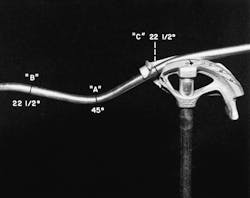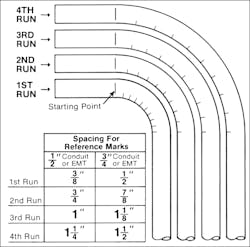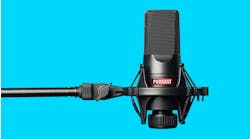Intro by Doug Chandler, Senior Staff Writer
When inventor and author Jack Benfield sat down to write the definitive guide to executing expert bends in conduit, he filled the small volume with solid, real-world explanations of everything from straight 90° bends to elaborate four-bend saddles and rolling offsets.
He threw in everything he had learned from visiting electrical job sites over several decades and talking to electricians about the tricks and techniques they used to build runs that were both elegant to look at and easy to pull wire through. Many of these tips he compiled into “Questions and Answers” sections in each chapter or turned them into rules of thumb under “Jack’s Timely Tips.”
Below we offer a selection of those tips, expanding on the list in the last installment of Basic Training (EC&M, April 2019, page C10), to make all electricians more proficient and more confident when it comes to bending conduit.
The Benfield Conduit Bending Manual is available as a printed spiral bound handbook or e-book at the “Shop” link via the EC&M homepage.
Basic Conduit Bending Tips by Jack Benfield
Here are some conduit bending tips the author has learned after many years of talking “conduit” with professional electricians all over the free world.
Stub-ups in narrow partitions. Bend a 45° or 60° kick in the conduit a few inches away from the partition. This allows the run to enter the partition obliquely. Thus, a conduit bend of conventional NEC radius will enter an unbelievably narrow partition with room to spare.
Bending both legs of an offset on the floor. Make the second bend on a slightly raised platform (a 2 × 4 will usually do) or bend at the edge of a loading dock, stairwell, etc. This allows the first bend to hang down in free air.
Marking conduit. Always girdle the conduit 360° with your pencil mark so it won’t disappear from view in the tool no matter which way you turn the conduit.
Out of shape hooks or grooves. If a rod-buster stretches the hook of the bender, pound it back with a sledge hammer or squeeze the groove in a carpenter’s vise until it returns to its original diameter. This applies only if the tool is of malleable iron.
Uniform long radii. First mark conduit in even increments, and bend in even amounts at each mark.
Gauging the back of a bend when it is less than 90°. Keep in mind that the starpoint on the tool is a stationary pivot point. Therefore, it indicates where the back of the bend will lay whether the bend is 1° or 90° — or any angle in-between.
If the back of the bend lays up an inch or two long, take another bite and overbend it to 120° or 130°. Then push the bend back to 90°. This will increase the radius, but the back of the bend will drop back an inch or two and lay up snugly.
On the contrary, if the back of the bend ends up short, straighten the conduit and re-bend it to a shorter radius using a hickey. Note: This applies only to ½-in. electrical metallic tubing (EMT).
Fig. 1. Conduit aligned for 22½° bend.
Three-bend saddles: Make the center 45° band first. Then make 22½° bends on each leg (Fig. 1). Don’t attempt a three-bend saddle if the object measures 6 in. or more in diameter. Larger diameters call for a four-bend saddle (Fig. 2).
Fig. 2. Here’s an example of a four-bend saddle routed around an obstruction.
Not all pipe saddles need to be made with the tool in the air (handle end on floor). But, if bending on the floor, you must make the side bends near the end of an elevated platform or at the edge of a loading dock or a stairwell. This allows previously made bends to lay in free air, thus providing firm solid footing because the portion to be bent lays flat on the floor.
Super-short radii with hickeys: On ½-in. or ¾-in. EMT, insert a snug fitting steel screen door spring within the EMT area to be bent. Make a hickey bend in several short bites — be rough, don’t baby it — but bend beyond a 90° bend. When you push it back to 90°, the pressure is released, and the spring can be easily removed. Note: a piece of armored cable, jumbo portable electric cord, a rope or a rubber hose will work as well if a suitable spring is not handy. But such inserts should fit snugly to provide internal support and be lubricated so they will slide out easily.
Don’t underestimate the importance of the uniform spacing between bites as the hickey is “inched along” during the bending operation (Fig. 3). Non-uniform spacing develops into a “sled runner” bend.
Fig. 3. Guide for concentric bends, performed with a hickey. Note that each run has nine bends, each segment bent 10° ― only the spacing of the segments changes.
Marking the conduit for precision bending. Some galvanized conduit finishes are greasy smooth. A lead pencil doesn’t mark clearly on such finishes. Use a soft tip marking pencil. Don’t make your marks on the conduit too wide. A pinpoint precision bend could miss by as much as the width of your mark.
How to remove a sharp kink in ½-in. EMT: Straighten the EMT by using the handle only as a combo lever and sleeve and push the bend back down to the floor progressively. The kink will nearly disappear. Now, rebend it in the same area in any direction you choose, but you must use extra heavy foot pressure to coin the kinked area back into round again.
For a professional-looking conduit job, bends should be trim (i.e., made to the proper radius). Bending tools that have been engineered to bend rigid or IMC make National Electrical Code radius bends. (Tools for EMT make awkward outsized radii when used to bend rigid or IMC.)
Bend rigid conduit and IMC on the floor. If you are right-handed, apply foot pressure to the foot pedal with your left foot. You will get better footing and feel more secure to have your right foot placed firmly on the conduit and floor. Note: Vice versa if you are a “lefty.”
Bend with a wide stance. The feet should be 28 in. to 30 in. apart. This provides better body balance and more power. Foot pressure is paramount. Pin the conduit tight to the floor with stiff leg foot pressure throughout the entire bend.
Custom handles. If you make up your own handles, use schedule 40 merchant pipe and cut tapered threads (like on steel water pipe). The threaded end should jam down tight before it bottoms out in the threaded bender socket. A loose-fitting handle is unsafe because it can turn in the middle of a bend.
The length of your bender handle is important. Handles should serve to better body balance, not solely as a lever for power. If handles are too long they get in the way. They also invite too much shoulder pull which lifts the entire tool and conduit off the floor and kinked conduit results. Soft steel handles of easy bending conduit should be reinforced by driving a smaller pipe (18 in. long) or a rebar into the threaded end with a sledge.
Questions and Answers
Q. What is a “sled-runner” bend?
A. A “sled-runner” is trade slang for a 90° bend that has an ugly, uneven arc. If conduit is allowed to bend outside of the body of a hickey or bender groove the result is a long radius arc bending into a short radius arc. Lack of sufficient pressure to “coin” the metal into a uniform arc results in a “sled-runner.”
Q. Can accuracy be maintained with hickeys or is it all guesswork?
A. Make a test 90° bend. Count the number of bites taken, then measure the take-up. Use this take-up on subsequent bends and your accuracy will usually be within ¼ in., plus or minus.
Q. Can a 90° hickey bend be altered up or down?
A. Yes, by reworking the bent portion into closer segments. This works providing the hickey grabs on without slipping. Reworking is limited to ½-in. rigid conduit but don’t attempt to rework EMT with a hickey — it kinks!
Q. Can hickeys be used to shift conduit stubs on concrete slab work in the case of a missed partition?
A. Yes. Usually it is best to remove the handle, placing the hickey head only on the conduit. The hickey handle is then sleeved over the conduit close to the hickey head and used as a lever to bend the “wandering stub” back into proper position. The hickey head is rested at the concrete floor level. Care should be taken to keep the “hook end” of the hickey towards the operator. Otherwise after bending the hickey may be locked tight to the floor by the bend.
Q. Should “rolling offsets” always be used to go around corners?
A. No. Rolling offsets are practical only when the direction of the conduit runs parallel to the corner to be turned.
Q. Must the angle of bends for “rolling offsets” always be at 30°?
A. No. In some cases, 22½° or 45° angle bends would work just as well. It’s a matter of journeyman’s choice. Wire pulling should be considered.
Q. I have trouble making saddles without dog-legs. How do I prevent this?
A. Before you make bends “B” and “C” (Fig. 1 on page C8), you should adjust the conduit in the groove (after completing bend “A”) until everything lays in one plane. “Everything” means the conduit, the bender groove and the bender handle too. As a further precaution align everything up with a straight mark of some kind on the floor. It could be the edge of a board, the seam of a carpet, the metal divider in a terrazzo floor, floor tiles, etc.
Q. How do I correct a ½-in. or ¾-in. EMT stub that has been knocked over and kinked flat together at the concrete deck level?
A. Don’t attempt to remove the kink with a hickey or bender. Instead, using an IPS sleeve over the EMT, push the stub back into the vertical position. (Much of the kink will disappear by doing this.) Now use a bullet-nosed steel rod to ram it down inside the EMT, turning it to and fro. This should bring the kinked portion back into round again.






